The Marciac Suite
A sonic photo album in 13 movements, all 12 keys, and four time signatures, this 76 minute suite is Wynton’s kaleidoscopic tribute to the beautiful medieval town of Marciac, France, and its August jazz festival in which he participates every year. Written for his septet, the suite captures the varied, bracing flavors of Marciac’s paté (including the duck that got away), its armagnac, its striking sunflower fields and, most of all, the hospitality and soulfulness of its people.
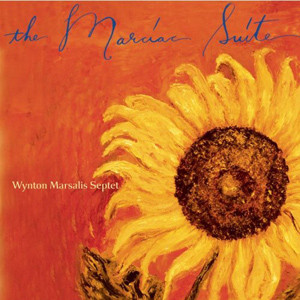
Album Info
| Ensemble | Wynton Marsalis Septet |
|---|---|
| Release Date | August 22nd, 2000 |
| Recording Date | February 1-2, 1999 |
| Record Label | Columbia |
| Catalogue Number | CK 69877 |
| Formats | CD, Digital Download |
| Genre | Jazz Recordings |
Track Listing
| Track | Length | Preview |
|---|---|---|
| Loose Duck | 7:18 | Play |
| The Big Top | 4:39 | Play |
| Jean-Louis Is Everywhere | 4:56 | Play |
| Mademoiselle D’Gascony | 6:04 | Play |
| Armagnac Dreams | 6:05 | Play |
| Marciac Fun | 5:20 | Play |
| For My Kids At The College of Marciac | 4:02 | Play |
| Marciac Moon | 9:27 | Play |
| D’Artagnan | 4:47 | Play |
| Guy Lafitte | 4:06 | Play |
| B Is For Boussaget (And Bass) | 3:58 | Play |
| In The House Of Laberriere | 5:52 | Play |
| Sunflowers | 9:58 | Play |
Liner Notes
Everybody knows Wynton Marsalis can blow up a storm. But on the night that his sextet premiered The Marciac Suite, they were almost blown away themselves – along with the immense circus tent that housed the concert and some 5,000 jazz fans. Halfway through Wynton’s 13-part composition, Jazz in Marciac Producer Jean-Louis Guilhaumon rushed onto the stage and announced that a powerful gale was headed directly for the town. “It is too dangerous to remain here,” he told the stunned audience. “We must clear the tent immediately.”
Rain was already battering the big top and turning the ground outside into muddy rivulets. As the crowd started to disperse, the musicians silently gathered their instruments and exited the stage. Their disappointment was palpable. Pianist Marcus Roberts seemed on the verge of tears. One of the young music students from the local school rushed up to Wynton in the backstage area and broke down crying. Wynton put his arm around the boy and consoled him as best he could. He didn’t look too chipper himself at that moment, but he had been in the business long enough to know it had its ups and downs.
The next day the storm had given way to sunny skies and the band regaled the public with a free open-air performance of the entire 90-minute work. The performance was a triumph, and Wynton left the stage with an ear-to-ear grin. He had done what he came to do: pay musical tribute to the town that, after his native New Orleans, is nearest to his heart. “It’s a question of chemistry,” he says of his attachment to Marciac, “like falling in love with a woman. I just love this place. I love the food. I love the festival. It makes me feel good to be part of the world here.”
Wynton is so much a part of the Marciac world – he has appeared there every summer since 1991 – that the festival has adopted him as its unofficial “godfather.” Whether performing onstage, chatting with fans and townspeople, playing basketball with local kids or teaching master classes at Marciac’s college (comprising grades six through nine under the French system), Wynton is totally at home in this medieval French town of 1,300 souls. “Wynton’s relationship to this festival is very special,” says Guilhaumon, a tall man with a graying close-cropped beard and the laid-back accent of his native Toulouse. “I have a lot of respect for him, because I think he is a powerful force for the development of jazz.”
Guilhaumon, who is also the local mayor and principal of the college, is the man most responsible for creating a world-class jazz festival in this unlikely rural setting. An inveterate jazz fan, he came to Marciac as an English teacher in the early 1970s and soon began looking for ways to liven up the sleepy village. In 1978, Guilhaumon convinced trumpeter Bill Coleman and tenor saxophonist Guy Lafitte, both of whom lived in the region, to play a concert in the local bull-running ring. It was such a success that Guilhaumon decided to host an annual festival in an empty furniture factory. As the crowds grew ever larger, the concerts were moved into a rented circus tent pitched on the local rugby field.
Over the past two decades, the Jazz in Marciac festival has blossomed into a major 10-day summer happening, attracting more than 100,000 people each August and presenting such legendary artists as Ray Charles, Dizzy Gillespie, Stan Getz, Sonny Rollins, Herbie Hancock, and B.B. King. In addition to the nightly concerts under the big top, the festival presents free concerts at open-air stages while concession stands offer such local specialties as foie gras, armagnac and the region’s excellent red wines.
As if that was not enough, Guilhaumon installed a jazz museum in a 15th-century Augustine cloister and set up an innovative jazz program that allows 6th through 9th grade public school students the option of taking up to five hours of special music instruction per week. The teaching scheme was an instant hit, attracting students from across the country and helping to nearly double the student body. As a result, says Guilhaumon, “it practically saved our little rural school from extinction.”
For Wynton, a natural-born teacher, the school program was one more reason to love Marciac. And for Marciac to love him. Every August, he makes time for master classes with “his kids.” “To me, the source of all a teacher’s power comes from the creative playing of the music itself,” he says. “You communicate a lot more than what you tell the students. Teaching is a very spiritual thing.”
In 1997, Guilhaumon came up with a very special way to commemorate the town’s bond with Wynton: he commissioned a life-sized bronze statue of the trumpeter from sculptor Daphne du Barry. Unveiled at the beginning of the festival that year, the work now occupies a place of honor in front of the ancient cloister. Wynton reciprocated that tribute by composing The Marciac Suite.
“Jean-Louis kept asking me to write something for Marciac, but I was always too busy,” says Marsalis. “Then they commissioned the statue and that prompted me to get it together. I wanted to write a piece that expressed all my feelings about the festival, the town and the people there.”
The complex 13-part work ranges from sensual ballads (Mademoiselle D’Gascony) to percussive outbursts (D’Artaganan) and circus-like exuberance (Marciac Fun). The anecdotal composition also includes musical evocation of some of the people who make Marciac so special for Wynton: Guilhaumon (Jean-Louis is Everywhere), Lafitte (Guy Lafitte), bassist Pierre Boussaguet (B is for Boussaguet [and Bass]) and the local jazz students (For My Kids at the College of Marciac).
Wynton, of course, never does anything the easy way. Ranging through all 12 keys and four time signatures, The Marciac Suite is full of neck-snapping counter-rhythms, syncopations and intricate polyphonies. Result: it is hard to play, even for the most accomplished musicians. The problem was that Wynton was composing right up to the deadline and there was no time to rehearse it before the sextet arrived in Marciac for the premiere.
Fortunately, they got there four days before the performance and Wynton put the band through a day-and-night regimen of “woodshedding” at the hotel de France in nearby Auch. “Man, he had us rehearsing six or eight hours a day,” recalls bassist Rodney Whitaker. “We’d do three sessions, morning, afternoon and evening. The piece just blew me away, it’s so difficult rhythmically. We didn’t even know the names of the tunes until the night of the concert. We just learned them by number.” For pianist Marcus Roberts, who is blind, learning the composition presented a special challenge since he couldn’t read the sheet music. Wynton had sent him a rough cassette version of some of the tunes ahead of time, but mostly Roberts had to rely on his prodigious memory to master the piece.
The scene in the trumpeter’s dressing room before the premiere was surreal. The cramped space was filled with musicians, friends and well-wishers – including the pop singer and composer Carole King. Wynton, looking dapper in his designer suit and tie, was reading aloud from handwritten notes, explaining the meaning of each tune to the journalist he had enlisted to translate his announcements to the public.
“I’m going to say a few words about the tunes so people will know what it’s about,” he said. “See, like Sunflowers, that’s about the optimism of Marciac. That’s the first think you see when you come here, all those fields of sunflowers around the town. And Loose Duck, that’s about the duck who got away. Instead of being made into foie gras, he is found strutting around the town with a glass of armagnac in his hand. And in the House of Labarriere, that’s dedicated to this local family I stay with when I come here. Madame is slow tempo, deeply soulful. Monsieur is faster. They give me a real down-home feeling…”
The wind was already rising as the band entered the big top and took their places on the stage. The tent was packed and you could feel the excitement of great expectations as Wynton announced the first number. “This is Marciac Moon, a tune that speaks of the land, the haunted castles, the romance, the dance.”
Suddenly the tent was filled with melodies, rhythms, voicings and counterpoints that had never been heard before. The musicians and the audience shared a collective sense of being present at the creation. But the magic of that moment was soon interrupted by the approaching storm and Guillhaumon’s reluctant order to clear the tent. That frustrating anticlimax was only a prelude to the sunny public rendition the next afternoon. The storm seemed to have swept away the tension, and the music flowed joyously under the blue Marciac skies. One could only conclude that this was how it was meant to be.
Guy Lafitte, the honorary president of Jazz in Marciac, stood beaming at the side of the stage during that performance. The world-renowned French saxophonist had played here every August for 19 years and spoke proudly of the festival’s success. “Everybody comes here to be happy,” he remarked. “You never see a drunk or a fight here. It’s incredible.” Lafitte, who had developed a special friendship with Wynton over the years, was especially leased that the trumpeter had dedicated a tune to him in The Marciac Suite. That turned out to be Winton’s parting gift to Guy Lafitte: the saxophonist died of leukemia on July 10, 1998 at the age of 71. “Marciac will never be quite the same without him,” says Marsalis.
But the spirit of Marciac lives on. Wynton has captured it here as solidly as that bronze statue captured his own likeness. He has often said that his main mission as an artist is to “leave a legacy.” The Marciac Suite, and this remarkable recording, will be an enduring part of it.
Thomas Sancton
TIME Magazine
Credits
PERSONNEL:
Wynton Marsalis, trumpet
Wycliffe Gordon, trombone
Wessell “Warmdaddy” Anderson, alto saxophone
Victor Goines, tenor & soprano saxophone, bass clarinet
Eric Lewis, piano (on D’Artagnan, Marciac Fun, Jean-Louis is Everywhere & Armagnac Dreams)
Farid Barron, piano (on Sunflowers, In the House of Labarriere, Loose Duck, Mademoiselle D’Gascony)
Cyrus Chestnut, piano (on The Big Top, Guy Lafitte, Marciac Moon, B is for Boussaget [and bass])
Marcus Roberts, piano (on For my Kids at the Collège of Marciac)
Rodney Whitaker, bass
Herlin Riley, drums
Roland Guerrero, percussion (on Marciac Fun)
All compositions by Wynton Marsalis (Skayne’s Music/ASCAP)
Produced by Delfeayo Marsalis
Production Coordinator: Dennis Jeter
Recorded at Masonic Grand Lodge, NY, February 1-2, 1999
Engineer: Patrick Smith
2nd Engineer: Aaron Spencer
Technical Engineer: William McNeil
Tape Operator: Daryl Dickerson
“For My Kids at the College of Marciac” Recorded by Les Stephenson
Piano provided by Steinway
Mixed at Signet Soundelux, Los Angeles
Engineer: Patrick Smith
Assistant: Brian Dixon
To obtain more wood sound from the bass, this CD was recorded without usage of the dreaded bass direct.
Recorded Dolby SR analogue, mixed to Pro-tools 24-bit digital via Apogee AD 8000 converters
Edited by Jalmus at the Westwood Marquis, Suite 1204, Los Angeles
Technicians: Brad Cobb &: Ron Garrett
Equipment provided by Audio Affects
Bass Consultants: Monk by 5 & Marc Lombardo
Mastered by Jalmoose at Signet Soundelux, Los Angeles
Additional recording at TMF Studios, NY
Wessell “Warmdaddy” Anderson appears courtesy of Leaning House Records.
Cyrus Chestnut appears courtesy of Atlantic Records.
Victor Goines appears courtesy of Rosemary Joseph Records.
Painting by Lisa C. Soto
Art Direction: Kiku Yamaguchi
Design: Risa Noah
Photo collage:
1. Alquier
2./3. Philipe Gerard Dupuy
4. Michel Carossio
5. Philipe Gerard Dupuy
6. Chateau Daphne Du Barry
7. Michel Carossio
8. Alquier
Back cover photo:
Michel Carossio
Personnel
- Cyrus Chestnut – piano
- Farid Barron – piano
- Eric Lewis – piano
- Marcus Roberts – piano
- Rodney Whitaker – bass
- Roland Guerrero – percussion
- Herlin Riley – drums, tambourine
- Wess “Warmdaddy” Anderson – alto sax, sopranino sax
- Victor Goines – tenor sax, soprano sax, clarinet, bass clarinet
- Wycliffe Gordon – trombone
Also of Interest
-
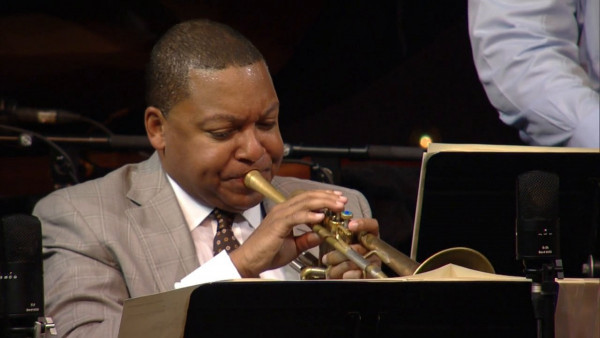 Videos
Videos
Jean-Louis is Everywhere - Wynton Marsalis Septet at Jazz in Marciac 2014
-
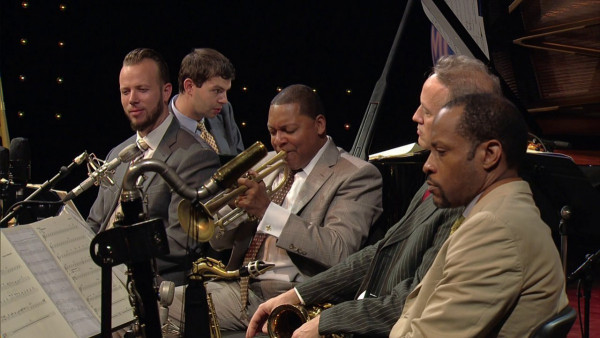 Videos
Videos
Mademoiselle D’Gascony - Wynton Marsalis Septet at Jazz in Marciac 2014
-
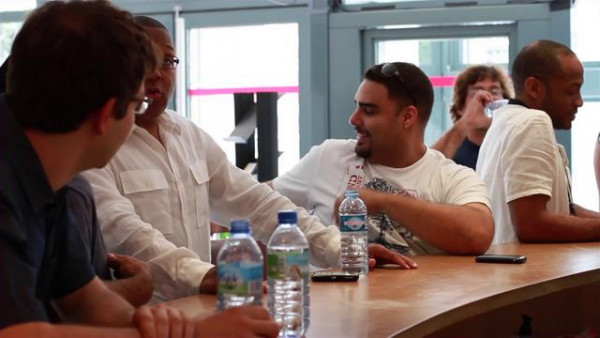 Videos
Videos
Behind the scenes at Jazz in Marciac 2010
-
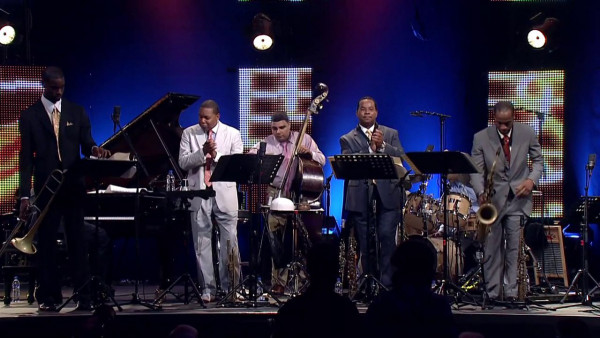 Videos
Videos
Sunflowers - Wynton Marsalis Septet at Jazz in Marciac 2010
-
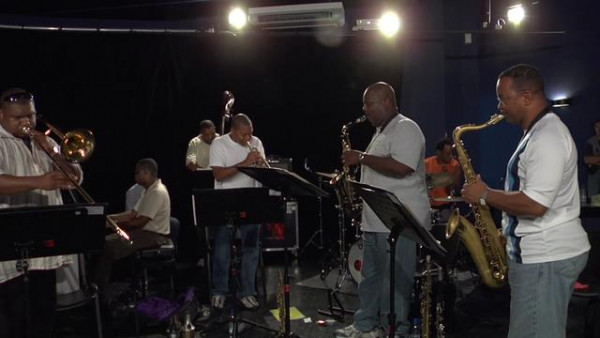 Videos
Videos
Sunflowers (rehearsal) - Wynton Marsalis Septet at Jazz in Marciac 2008
-
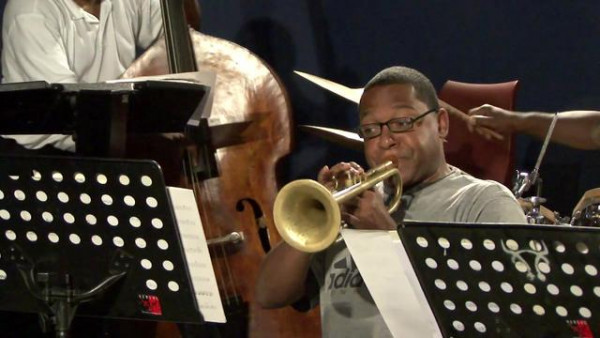 Videos
Videos
Marciac Fun (rehearsal) - Wynton Marsalis Septet at Jazz in Marciac 2007
-
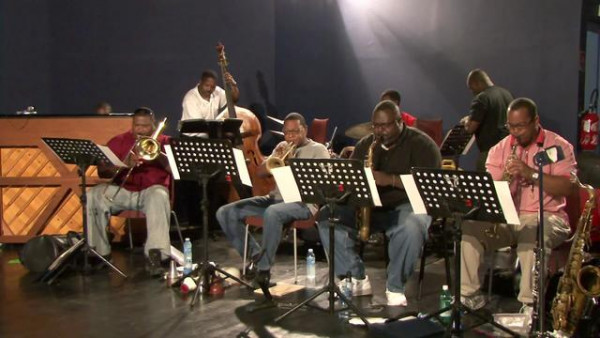 Videos
Videos
Loose Duck (rehearsal) - Wynton Marsalis Septet at Jazz in Marciac 2007
-
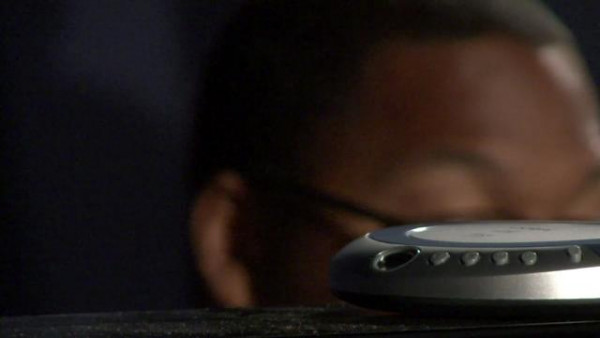 Videos
Videos
B is for Boussaget (rehearsal) - Wynton Marsalis Septet at Jazz in Marciac 2007
